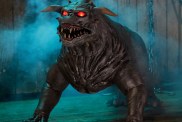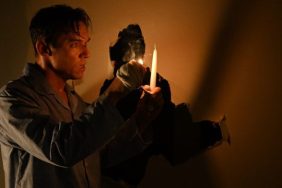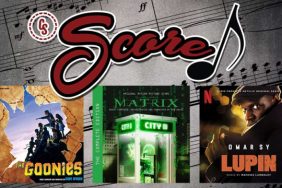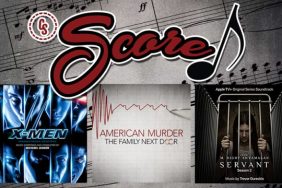
Electronic music pioneer Charlie Clouser talks to SHOCK’s Joe Yanick about NIN, SAW, WAYWARD PINES and more.
With the release of James Wans original SAW, his first feature soundtrack work, Charlie Clouser had already amassed an impressive resume. Having spent 8 years with Nine Inch Nails, he worked his way from technician to performer. He also appeared as either as a performer, engineer, remixer, or producer on an array of artists works, including Killing Joke, Deftones, and White Zombie. Like the franchise itself, since the release of SAW, Clouser has evolved to become a major force in the composing world. Working in both television and film, his stylistic tendencies have guided not only every installment in the SAW series, but formed the basis for RESIDENT EVIL: EXTINCTION, DEAD SILENCE and shows like AMERICAN HORROR STORY, LAS VEGAS and, most recently, the M. Night Shyamalan- produced mini-series WAYWARD PINES. Needless to say, Clouser has kept busy.
SHOCK caught up with Clouser between projects in order to chat with him about the difference between analog and digital, his transition from Industrial Rock to composition, and what dark treat he has in store for us next.
SHOCK: Youve had a varied career in the industry but lets take it back to the beginning. How did you find your start?
CHARLIE CLOUSER: In the 80s, as I was just starting out in the music industry and working as a session programmer in New York doing synth and drum programming on records I started to become more aware of the birth of industrial rock. For me, it was attractive because it was in the spirit of sonic experimentation; here were sounds that you hadnt heard before. Ive always been really attracted to studio technology, experimentation with equipment, and making new sounds. You know, first discovering bands like Killing Joke and Public Image Ltd., things that were more Post-Punk than industrial but still had this disregard for conventional approaches of rock. So that is what led me down that path to discovering Nine Inch Nails and bands of that nature.
SHOCK: What exactly was the kind of work were you doing at this point?
CLOUSER: In the late half of the 80s, besides doing record stuff I was already working as a programmer and number three man for a TV composer in New York. We were working on this crime drama called THE EQUALIZER. That is where I actually started working on scoring stuff, before I really got too involved in the record industry.
SHOCK: What does a number three man do on a composing team?
CLOUSER: It was a three-man team. The guy whose name went on the show, an Australian composer named Cameron Allan and he had brought with him from Australia John Clifford who had worked on records with him. Neither of them were all that technical. Cameron was more of a producer. My gig was basically to set up and configure the system. I would also do all the drum and percussion programming and all the scary noises that you will get in a suspense or thriller score, by sampling different sounds and pitching them down and making interesting stuff using the crude samplers and synths that we had in the 80s. Then, Cameron and I would mix the score. It was just the three of us and we had crank out 22 episodes, one a week for six of seven months. We had to work fast, so we kept a fairly streamlined and small set-up.
SHOCK: Sounds like you got a crash course in composing.
CLOUSER: Absolutely, and working with Cameron was really where I got to see how the sausage gets made, in a scoring situation. So, then, 15 years later when I left Nine Inch Nails and came to LA to get back into scoring, I wasnt just coming out of a rock band with that set of skills. I had already done years of work with scoring and I was able to hit the ground running.

SHOCK: How did you meet up with Trent Reznor and Nine Inch Nails?
CLOUSER: It was working for that composer that brought me from New York to Los Angeles, where I reunited with a bunch of college friends from back east one of whom was one of many producers on a Nine Inch Nails music video. [Nine Inch Nails] needed some sound effects for the Happiness in Slavery music video, which had this performance artist Bob Flanagan being eaten alive by this mechanical torture chair. They needed the sound effects that the mechanical chair was going to make: sort of motor and meat grinder-type sounds. They had all the gear they needed, they just needed someone to bring in new sounds and a different approach. I showed up with a disk drive that had a bunch of samples of stuff like dentist drills, jackhammers, and shit like that. So we manipulated a bunch of sounds and did this thing as basically an overdub for the music video. We finished it in just a couple of hours and had all this extra time, so Trent and I spent the rest of the time playing video games and screwing around in the studio and, then, before I left he said, well I have this other thing that I am doing that I was wondering if you could help me out on. He was in the final stages of the The Downward Spiral album while at the same time producing the Marilyn Manson record and didnt have the time to fix the drums on the Manson record. So he had me do drum replacement and fatten up the acoustic samples. So once I got there, I kind of never left.
SHOCK: How long did you stay on as a behind-the-scenes member of the group?
CLOUSER: Before I was playing on stage with the band, I went on the road with them for quite awhile setting up and operating a portable studio. We had a bunch of computers and synths that wed haul around in the buses and would set it up in hotel rooms whenever there were a few days off so Trent could do some writing. I did that for a while. Eventually, the original keyboard player James Woolley was fixing to leave so it was like, hey dude, youre up. I kind of took over in the middle of the tour. My first gig ever playing keyboards live and in front of people was for like 20-some thousand people at the Palace of Auburn Hills outside of Detroit.
SHOCK: What was that era like for performing? It is kind of the border between a major analog-to-digital crossover.
CLOUSER: It was really a great time to be involved with someone like Trent, who was at the cutting edge of sonic experimentation. As we went on, we started to get more digital and software-based tools, but were right there on the bleeding edge of it, using funky old PC computers with shareware programs to granulate and manipulate samples. That formed a big part of the sound of the The Downward Spiral and The Fragile albums. Its a different context but I can still apply a lot those same attitudes towards experimentation with sound in the scores that I do.
SHOCK: Youve really witnessed and been an active part of huge revolution in electronic music. Do you think something was lost (or maybe gained) in the move from hardware-based to software-based equipment?
CLOUSER: Back in the hardware era, you did have to work a lot harder to get the results you wanted. You werent sitting in front of a workstation where you have a trillion sounds of every possible variety that you can recall with just three click of the mouse. Your thought process was a little different. When you were starting off a track and looking for a particular sound, youd have to go to a particular instrument with the knowledge that it was really good at only a couple of things. Maybe youd have a couple of accidents in getting it to do something it wasnt intended for, but the limitations of a particular piece of hardware would guide you to a destination, to some degree. Youd be bumping up against those limitations to get to your end result. Now, obviously I work with a lot of software tools and big computer set-ups. I still have all of the hardware stuff from back in the day but the amount of time that it takes to get a result from the old hardware is so much greater than with software. It just wouldnt be practical to use all of my favorite hardware from back in the day for most things, but I do break it out on about a quarter of any given project I am working on; for those particular interesting sounds that I know I can get because Ive had some of those instruments for so long. The one thing that I really dont miss about the hardware era is the fact that with modern digital set-ups and mixing inside of the computer it is much cleaner and easier to use very quiet sounds that are compressed and boosted to play loud, which is something that I do a lot in scoring. That was always difficult in the hardware era because youve had background noise, hiss, and hum. Having turn off the air conditioner or fridge because it would cause noise in the guitar pick-ups.

SHOCK: In a way, SAW kind of started it own little sub-genre of horror films. Was it a challenge to try and remain out of a bubble with each subsequent film, as not only the franchise but the films many offshoots began to evolve?
CLOUSER: The first SAW movie I did very quickly at the same time that we were finishing up an album by the band Helmet, which we were also recording at my house in Hollywood. They were recording and editing vocals for Helmet in one room of my house, while I was doing the score for SAW in the B room. I had to do it very quickly because, as usual, they were up against a deadline. At the time, I hadnt worked at scoring projects in 10 or 15 years, so I did it very minimally. I didnt use a lot of equipment; it was all done in a computer with samples, synths, and plug-ins. I wasnt trying to do things like fake a big string section in the computer or whatever. As the franchise went on and different directors came on board, they kind of each had a different approach to how they wanted the movie to look and sound. So, over the course of the seven movies, at some points I would end up using big orchestral and choir sounds. I was doing things on some of the sequels I would have never done on the first movie and, likewise, I didnt bring forward some of the things that worked so well on the first movie. Of course, one thing we did exactly the same in every movie was the final flashback montage scene. For each movie, we would go back to that theme, called Hello Zep, and I would do a remix each time: make it a little longer and add some elements, while still retaining the same beginning and ending the original had.
SHOCK: Throughout your career, be it with Nine Inch Nails or scoring films and television, you tend towards darker subject matter and tonalities. Is this a sensibility thing for you?
CLOUSER: Im definitely more comfortable in darker more ominous subject matter because my natural tendencies both towards the sounds I like and the actual natural chords and melodies I like are best suited to that. I dont think Ill be doing a lot of romantic comedy-type scores anytime soon [laughs] because my natural tendencies in music dont go in that direction so much. Sometimes I look at it like I am a Sherpa at Mount Everest. For the guy who is coming to climb Mount Everest, this is the first and maybe only time he is ever going to do this. He is so excited but the Sherpa is the guy who has been up the mountain 50 times. Its kind of good to already know the different ways up the mountain because it is still an adventure but you dont risk falling into a crevasse because you took a different path. So I dont mind specializing in that subject matter because it is a good fit.
SHOCK: I think it is interesting that both you and Trent have transitioned into scoring. Based on what youve said of your relationship with Trent, do you think that youve both find your ways to scoring because it grants you freedom to experiment with sound outside of traditional music?
CLOUSER: One factor is definitely that. Trents music with Nine Inch Nails was fairly unconventional but there is still an inherent road map that exists in making rock albums even though he deviated from that masterfully with albums like the Ghosts series, which was much more freeform and spacey. When you are working with scoring a picture, all of a sudden the road map is completely out the window. It has nothing to do with song arrangement. That roadmap becomes imposed on you only by what is happening on the screen. Making a rock album is almost like painting a portrait of a person. It might be a very realistic portrait or it might be a Van Gogh or a Picasso, where it kind of looks like a person but it is still trying to represent something that exists in real life. Whereas scoring to picture is almost like doing full-on abstract art like Rothko or Jackson Pollack. I think that both Trent and I have a natural inclination towards experimenting with sound and unconventional musical construction and that is a natural skill-base and set of talents that apply well when scoring for picture. I am not at all surprised that is something that he also got into and is doing super well.

SHOCK: WAYWARD PINES, which has wrapped up, is your most recent work. It is still unsure what the future of the show will be but there are rumors of a second season in potential works, have you been tagged to work on it?
CLOUSER: I dont know if theyll be able to get another season happening. There are other chapters and books in the story so, in theory, they could continue. As far as working on the show is concerned, it was definitely in my ballpark but not exactly what I am necessarily known for. The sort of uneasy, unsettling aspect to the storyline was actually a pretty good fit for my approach musically, because I was able to use a lot of sounds that were wobbly, uncertain, and a little out of tune and out of whack. It was interesting because when I started to work on it, I hadnt read the books and I didnt know the full layout of where the story was going to go. They brought me in and were like alright get to work on these episodes, so I didnt have time to understand the whole story until I was already into it. I didnt know it was going to turn into this epic journey that goes 4,000 years into the future. It was a case where being in a hurry worked out because the music in the first couple episodes is very different that what ends up in the last few episodes as the story changed.
SHOCK: So, whats next?
CLOUSER: Well I am hoping to get involved with Chad Hodges next project, who was one of the creators on WAYWARD PINES. At the moment, I just started doing the score for a television adaptation for the classic sci-fi novel by Arthur C. Clarke CHILDHOODs END, which is going to be on the SyFy Channel sometime in December. It is going to be a 6-hour long mini-series, airing in two-hour chunks over three nights.









